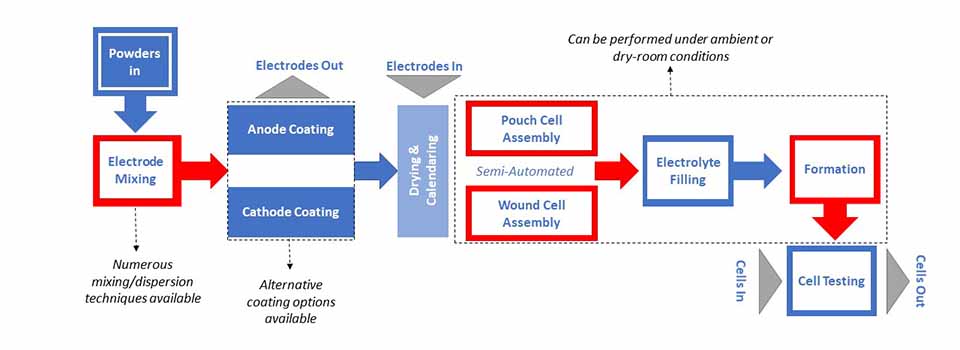
Energy storage
Graphene offers an ideal solution to many of the materials requirements for batteries and supercapacitors.
If you had a really good battery, it wouldn't matter that the sun goes down at night and the wind stops blowing.
Nathan Myhrvold / Visionary technology and business leader
It has lots of surface area for the physical and chemical mechanisms of energy storage to occur while being one of the most electrically conductive materials yet known.
The GEIC Energy Laboratory gives our members and project partners access to what is in essence a miniature production line for battery and supercapacitor coin and pouch cells. Couple this with support of the unrivalled expertise of this advanced material found at The University of Manchester and we believe we have the ideal recipe for success in development of fully scalable routes to advanced energy storage devices.

Most energy storage device production follows the same basic pathway (see figure above);
- Produce a battery/supercapacitor coating slurry.
- Coat a substrate with this and cure to produce a functioning electrode.
- Calendar (squash) the electrodes to optimise the structure and conductivity.
- Form the physical architecture of the device.
- Fill the device with electrolyte
- Conduct a formation cycle to ensure the cells are working properly.
- Test the cell performance.
Our team is available to help devise projects, guide product development and undertake research in collaboration with our members. We work with a number of UK and international partners to give our members access to world class expertise and develop prototype devices.
The services we offer can be collated into four packages which cover the range of our capabilities. These are broadly in-line with standard practices but The GEIC also offers the opportunity to include modular technology in order to incorporate more disruptive techniques where appropriate. All of these packages can of course be tailored to deliver a package of work which meet your specific requirements.
Formulation
Our formulation package is designed to give access to all necessary equipment for formulation development of electrode coating slurries featuring advanced materials such as graphene.
This package includes:
- Dedicated bench space and fume cupboard access
- Tools such as planetary vacuum mixers and vortex mixers for production of coatings
- Automated film former to test the quality of the coating and suitability to scale-up
- Characterisation of electrical performance, rheological properties, dispersion and particle size analysis
- Access to -40C dew point dry room (optional)
- Access to argon-fed glove boxes (optional)
This package allows our members to design, formulate and test new electrode slurries using their chosen materials for downstream production and testing of electrodes.
Please contact us for more information on pricing and availability.
Electrode production
This package will develop scalable processes for production of electrodes. The package includes:
- Bench scale (<A3) production of coated substrates
- Process development and parameter specification for roll-to-roll manufacture of coated, heat-cured and calendared electrodes (on roll)
- Semi-automated cutting of coated electrodes to specific dimensions
- Modular capabilities also include electrode and/or (micro)device development via:
- UV-cure of coating slurries
- plasma etching of substrates
- screen printing
- ink jet printing
- conventional spray
- ultrasonic spray pyrolysis
- chemical vapour deposition (CVD) of thin films such as monolayer graphene
- other methods by request
- Access to -40C dew point dry room (optional)
- Access to argon fed glove boxes (optional)
Please contact us for more information on pricing and availability.
Cell assembly
This package aims to develop fully scalable processes in order to produce stacked or wound electrode structures - which are the heart of the energy storage device - and build them into working pouch cells. Our standard pouch cell dimensions are 53.5x35mm but we can accommodate other dimensions by request. We can also produce coin cells in order to perform smaller scale testing.
This package includes:
- Coin cell production capability
- Access to automated cell stacking facility
- Access to automated winding facility
- Pouch formation and sealing
- Automated electrolyte injection
- Formation cycling
- Access to -40C dew point dry room (optional)
- Access to argon fed glove boxes (optional)
Please contact us for more information on pricing and availability.
Materials, component and cell testing
This package includes access to extensive testing capability including:
- Rotating disk electrode for analysis of the electrochemical performance of raw materials and their suitability to energy applications
- Battery/supercapacitor cycling to analyse performance and durability of energy storage devices
- Electrochemical impedance spectroscopy (including high current capability) for analysis of individual components within the device
- Testing of cell performance within simulated environmental conditions (by arrangement)
- Analysis of electrode structures at start-of-life
- Analysis of electrode structures at end-of-life (by arrangement)
- Access to fuel cell and redox battery testing facilities (by arrangement)
Please contact us for more information on pricing and availability.
Our team
- Nicky Savjani - Application Manager
- I-Ling Tsai - Application Specialist (batteries)
- Qiang Li - Application Specialist (supercapacitors)

Our dedicated team empowers your business by harnessing 2D materials in energy applications. We provide comprehensive support in materials selection, experimental design, and product development for advanced batteries and supercapacitors. With expertise in statistical experimental design, we streamline testing by focusing on critical variables for cost-effective results. Get in touch to collaborate.
Nicky Savjani / Application Manager
